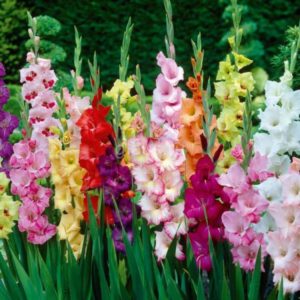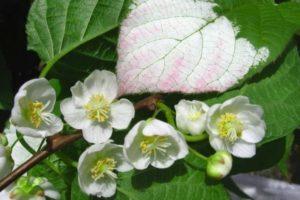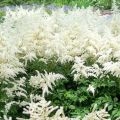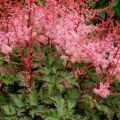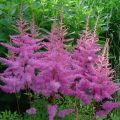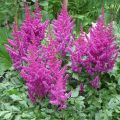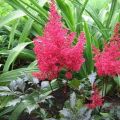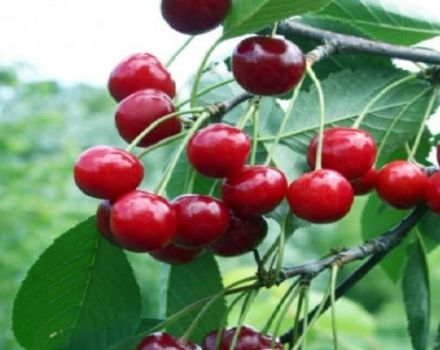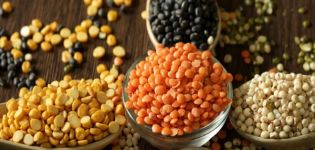Characteristics and description of astilba varieties America, planting and care
Astilbe takes root well in places exposed to the sun. Its above-ground stems die off in the fall, but with the first warm spring, the root system, which easily tolerates a frosty winter, quickly gives fresh shoots, and in summer astilbe, as in America, grows and blooms profusely. Its stems grow in height by 60-90 centimeters, can be up to 2 meters. The plant belongs to decorative, perfectly decorates summer cottages.
Breeding history
Scientists from different countries took part in the selection of astilbe. A botanist from France - E. Le Moine, created several varieties that received his name. Astilba Arends is named after the German botanist G. Arend. He devoted most of his life to the cultivation and selection of this amazing plant, bred astilbe with inflorescences of pink and bright red shades.
Need to know! Today the selection continues, more and more new hybrids are being bred.
Description and characteristics of culture
The shrub plant is distinguished by feathery and carved leaves of a dull, matte shade. Some varieties have shiny foliage. The main color of the leaves is dark green, but there are many varieties of the plant, and in many the foliage has a red tint, in some species the jagged edges of the leaves are outlined with a white border. The foliage grows densely on long, strong petioles of a reddish hue.
External description
In a perennial plant, erect stems die off for the winter, but the root system continues to develop and live in winter frosts. The density of the stems differs according to the varieties of the flower - it may be loose, but most often the stems are dense, woody.

Plant varieties differ in stem height - from 10 centimeters to 2 meters. In dwarf species, the stem length does not exceed 30 centimeters. In tall species, the stems grow up to 2 meters.
Bush
Bushes in different species are compact, but most often they are spreading, carved foliage gives the shrub a showiness even without flowers.
Bloom
The color of astilbe flowers depends on the species. Gardens are decorated with pink, purple, white, light purple, red flowers. The inflorescences are collected in brushes and look like openwork panicles. The shape of the inflorescences is pyramidal, diamond-shaped, drooping.
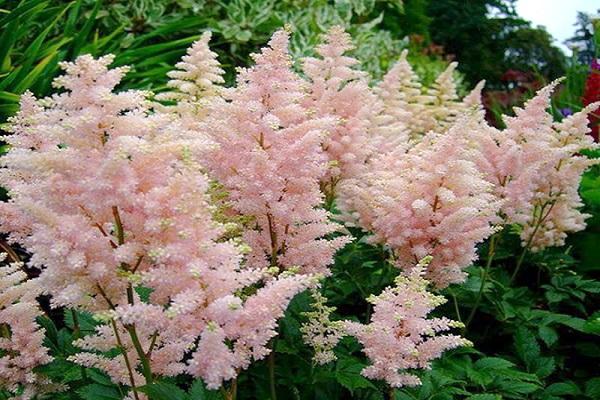
Root system
The rhizome, due to the fact that the plant is perennial, is distinguished by its high density and branching. Fresh root buds are formed on the surface roots by spring, the lower ends of the deep rhizome die off on their own, they do not need to be cut off during transplantation.
Frost and drought tolerant
The onset of autumn cold weather does not frighten the plant. It ceases to bloom, the stems with color must be cut off in time with pruning shears. But until winter, the plant adorns the garden with carved fluffy foliage. It is necessary to cut off the stems wilted with frost with the arrival of a real cold snap. After pruning, the shrub should be covered with dry soil, forming mounds 3-4 centimeters in height.
Astilbe is highly resistant to frost, withstand freezing of the ground down to -23 ºC, with external cold up to -37 ºC. Saves the plant from freezing and a layer of snow, and mulching introduced after pruning. Caring summer residents cover the astilbe bushes with spruce branches for the winter. Frost resistance zone: Moscow region, northern regions of Russia and mountains of Scandinavia.
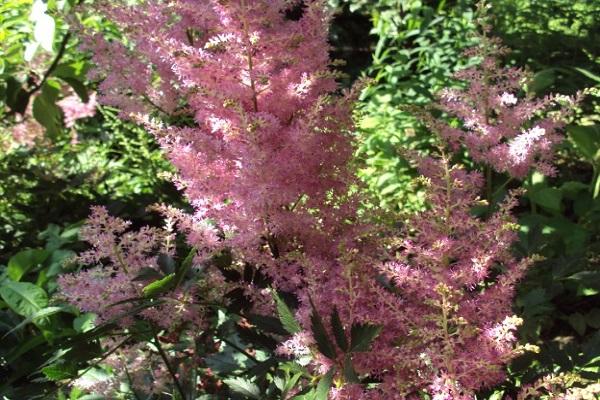
Astilba should be watered abundantly - it does not tolerate dry summers. The soil must be kept slightly moist at all times. The lack of moisture negatively affects flowering, the general condition of the plant. Astilba should be watered every day, in dry season - twice: in the morning and at night.
Note! Astilba is frost-resistant, but does not tolerate drought.
Susceptibility to diseases and parasites
Astilba America is resistant to diseases and pests. Only in conditions of insufficient care is it susceptible to root rot, spotting of the outer bush of a bacterial nature and phytoplasmic diseases of viral origin.
A sick bush can be revived: it is dug up, rotten areas, diseased stems and leaves are cut off. Then the roots are placed in a weak solution of manganese or fungicide. After keeping the root system in the medicine for a while, the plant is transplanted to a new place, the soil infected with rot is poured with a saturated solution of potassium permanganate, and left, without planting anything in this place for a long time.
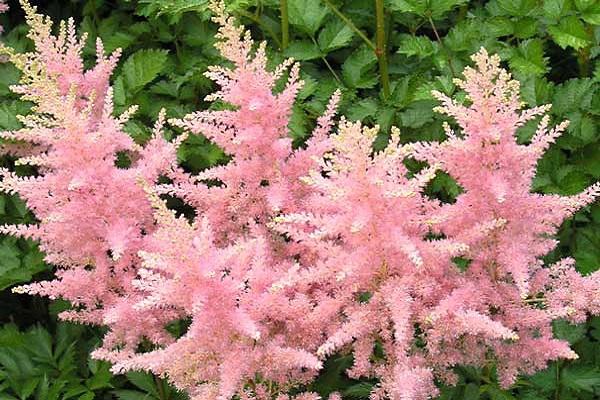
Bacterial spot disease is manifested by the appearance of black spots on the leaves, from which the plant withers. They destroy bacteria by treating the bushes with preparations containing copper. The causative agents of viral diseases can enter the plant along with the brought soil or when infected planting material is acquired. Viral diseases on plants are not curable.
Pests parasitizing on astilbe:
- slobbering pennies;
- small cicadas;
- gall and strawberry nematodes.
The plant is saved from pennies and cicadas by processing with Rotor, Aktara, Confidor. It is difficult to rid the earth of nematodes, and this is a type of helminthic invasion: it is necessary to completely remove the diseased plant, burn it on the spot.
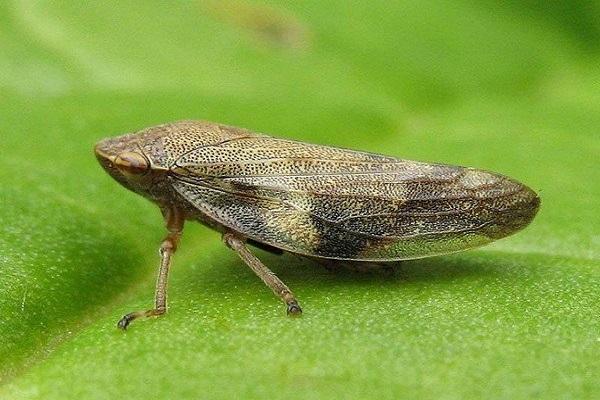
Attention! You should not plant other crops on contaminated soil for a couple of years.
Benefits of application in landscaping
Astilba America is a plant in demand in gardening. It is planted in monogroups so that they set off other shrubs with their colors. One astilba bush looks elegant against the background of conifers. The best place for astilba is partial shade near artificial reservoirs. This shrub sets off well many garden plants, their best neighbors are ferns, irises, hosts, heuchera, badan, geranium.
Astilba is in perfect harmony with bells, phlox, iberis, swimsuit. Creates an excellent background for low perennials: lamb, saxifrage, tenacious. Astilba forms a beautiful border, moreover, does not require much hassle in maintenance.
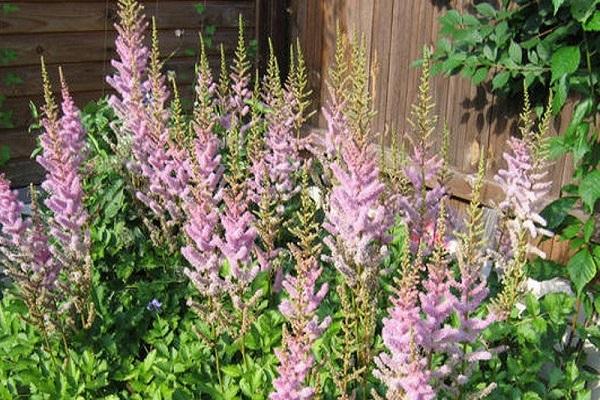
How to plant a plant
The soil is required sourish, with a pH content in the range of 5.5-6.6. Neighbors such as hosts help keep the soil moist, protect the exposed roots of astilbe with thick foliage from overheating in the summer heat.Since astilbe bushes need constant moisture, it is best to plant them near water. If it is not possible to regularly water the shrub, it is necessary to plant the astilba in the shade, to ensure the mulching of the soil at the root system with sawdust, caked hay, peat.
We must remember! Astilbe needs sunlight for at least 2-4 hours a day, then it will show all its decorative effect, the inflorescences will be thick and fluffy.
Timing
Five-year-old astilba bushes require seating, dividing the rhizome. This is best done in spring or early fall. Dates depend on the place of residence. In the Central lane, in the Moscow region, planting begins earlier than in the Urals and in the Siberian region, but later than in the southern regions. Astilbe should be planted in open ground in May, in an already warmed earth.
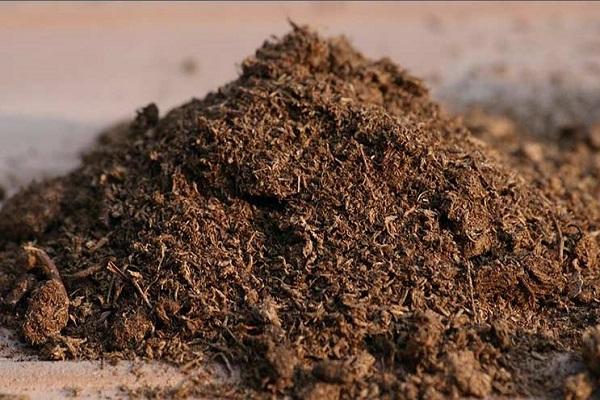
In general, Astilbe is unpretentious in terms of landing. If the planting material got to gardeners in the summer, it can be safely planted on cool days.
Choosing a suitable location
The landing site for Astilba America should be found in partial shade, if possible, on the north side of the buildings. But with such a condition that direct sunlight will fall on the bushes for 2-4 hours. Constant sunlight will destroy the bushes, and partial shade is the most desirable place for them. Areas with high ground water are not suitable, it leads to the charm and strong wetting of the root system.
For growing Astilba, shade areas with light soil rich in nutrients are well suited. Such soil allows the roots to breathe enough, as it is well filled with oxygen.
Need to know! The determining factors in choosing a site for planting Astilba America are indicators of moisture in the soil and in the air.
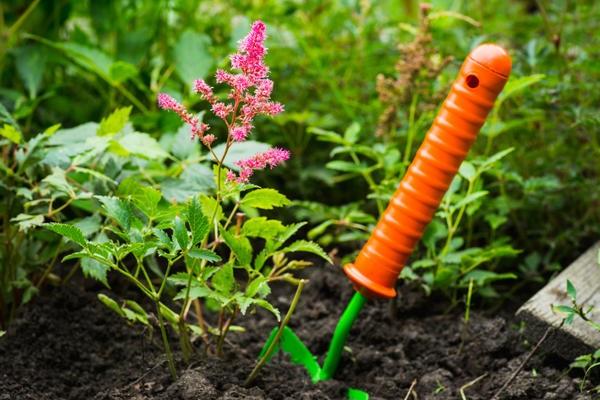
Preparing the soil and planting pit
First, the soil at the place chosen for astilba must be carefully dug up, rotted peat, rotted manure must be added to the soil. Fertilizers are applied in 2 buckets per 1 square meter. During digging, you should remove the roots of old weed plants that come across. After digging, the flower bed should be left alone for 2-3 weeks.
After this time, in the prepared place, you should dig holes, keeping a certain distance between them:
- 30 centimeters for undersized astilba species;
- 50 centimeters for tall varieties.
At the bottom of the holes, it is recommended to apply top dressing in the volume of matchboxes - bone meal, mineral fertilizers, wood ash. They must be mixed with the soil, and a hydrogel is added to the bottom of the hole for long-term preservation of soil moisture.
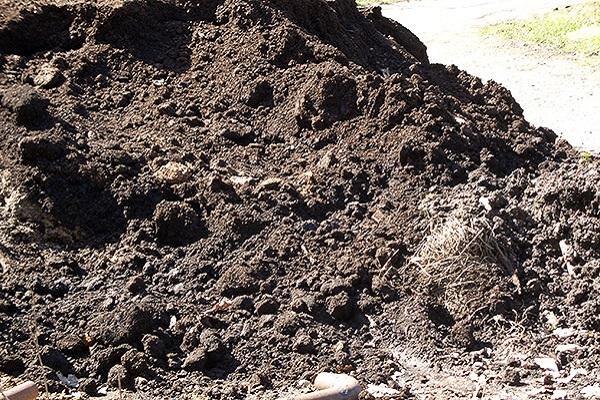
Planting technology and depth
The root system is lowered into the hole, carefully straightened the thin root processes, then covered with soil, tamping it a little so that there is no air space left. The pits are prepared in depth, according to the size of the rhizome.
After planting, a watering trench should be formed for each bush, water should be poured; when it is absorbed into the ground, under the bush it is necessary to mulch with chopped peat, sawdust, compost, crushed dried bark. In this case, you need to leave free, do not cover green shoots.

How to care for astilba
Proper care will ensure full growth and lush bloom for astilba bushes. Growing young roots emerge on the soil surface. In order for astilba to endure the harsh winter well, the roots must be mulched. In late autumn, closer to the coming frosts, you need to cover the soil over the roots of needles, sawdust, spruce branches.
Care includes activities that meet the specific needs of the shrub:
- Timely and sufficient watering.
- Making the necessary feeding.
- Timely pruning of wilting stems.
- Obligatory removal of stems with flowers.
- Proper preparation of bushes for wintering.
Astilba tolerates a harsh frosty winter if the bushes are properly mulched. Taking care of astilbe bushes is not difficult.
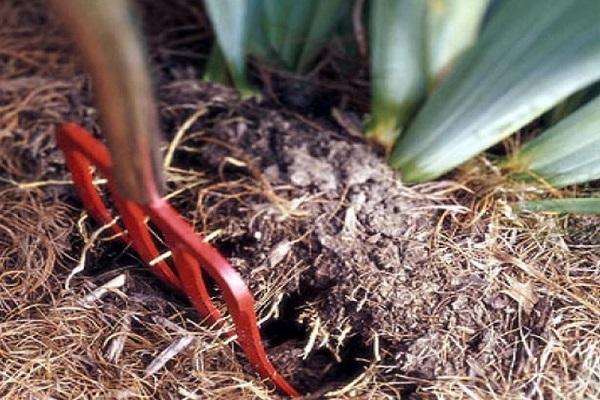
Watering and feeding
With the beginning of the summer heat, it is necessary to water the plant on time - it loves water, but in moderation - so that the root system does not become waterlogged. The lack of water has a detrimental effect on the plant - the foliage withers, the inflorescences become small. Annual feeding preserves the beauty and freshness of Astilba. For dry soil, compost or peat must be added; for wet soil, complex additives are added.
In spring, the bushes need to be fed with nitrogen fertilizers so that the greens grow more actively. For this, when loosening the soil under the bushes, a little humus is introduced. In the summer, before flowering, potash must be applied. Usually, when watering, potassium nitrate is added, a solution is made: 1 tablespoon of nitrate per 5 liters of water, pour in 0.5 liters per 1 bush. Autumn feeding is important when the plant stops blooming. At this time, phosphorus-potassium mixtures are introduced. Autumn feeding improves the winter hardiness of the root system.
Attention! Before applying top dressing, the land around the bushes must be watered abundantly. This is not done if it has already rained.
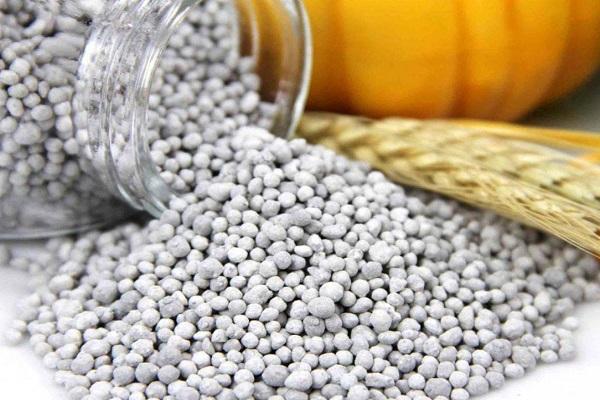
Loosening the soil
Astilbe bushes prefer loam of soft, loose quality for active growth. The rains in spring and summer compact the loam, this interferes with the breathing of the root system, and impairs the development of the entire plant. The air permeability of the soil increases loosening, it is recommended to carry it out 2-3 times a season. Loosening is carried out no deeper than 10 centimeters. Together with loosening, mulching is carried out, keeping the soil moist.
Pruning
Florists are sure: the perennial needs pruning after flowering. Thorough pruning of the stems with flowers is carried out, then, closer to winter, the rest of the wilting stems are cut, leaving the root system for mulching and warming. The snow will add a thermal cushion, protect the roots from frost. By spring, the root system will give young, strong shoots.
Preparing a flower for the winter period
The mild climate of southern latitudes with abundant snow makes it possible not to cover the bushes of Astilba America. In preparation for wintering, the bushes are important autumn feeding, pruning withered stems, mulching. It is recommended to cut the stems almost at the root, then the roots are spud, covered with a layer of mulch - from 5 to 20 centimeters, depending on the climatic zone.

How to propagate bushes
You can plant a bush without digging it out of the ground: free the root system from the soil a little, separate its shoots, fill the place where the shoots are cut with ash, fresh soil. This is how new seedlings are obtained without damaging the astilbe bush. Seedlings separated in this way give flowering already next year.
When such a division of the bush is done in early autumn, it rejuvenates the main plant. In winter, the root system is hard, almost woody, and this method of dividing the bush becomes impossible.

The main problems when growing astilba America
The process of growing perennial astilba in the open field is simple, which attracts gardeners. The main thing is to choose the right place for the plant.
The place for the location of the bushes should have optimal lighting, sparse shade, access to direct sun for several hours a day. Another important requirement for proper cultivation of astilba is a sufficient amount of water. A change in humidity has a detrimental effect on the appearance of the plant: the development of the root system is delayed, leaves fall, decorativeness is lost. In this case, you have to properly water the plant, re-mulch, and provide external spraying with water.
